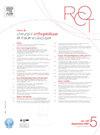Résultats des plaques verrouillées NCB-PP® dans le traitement des fractures périprothétiques du fémur. Analyse d’une cohorte rétrospective de 89 patients
Q4 Medicine
Revue de Chirurgie Orthopedique et Traumatologique
Pub Date : 2025-02-01
DOI:10.1016/j.rcot.2024.09.013
引用次数: 0
Abstract
Introduction
La prise en charge des fractures périprothétiques du fémur est particulièrement complexe, dans une population âgée et fragile, dont l’incidence est en constante augmentation en raison de l’accroissement des chirurgies prothétiques du fémur. Aujourd’hui, l’utilisation des techniques d’ostéosynthèse verrouillée est largement recommandée. L’objectif principal de cette étude était d’évaluer les résultats fonctionnels et radiologiques des plaques verrouillées NCB-PP® dans la prise en charge de ces fractures périprothétiques du fémur. L’objectif secondaire était de déterminer l’influence du délai de remise en charge sur la morbimortalité ainsi que sur le niveau de marche. L’hypothèse était que les plaques NCB-PP® donnent des résultats radiocliniques équivalents aux données de la littérature sans influence du délai de remise en charge sur le taux de complications et le niveau de marche à 1 an postopératoire.
Matériels et méthodes
Quatre-vingt-neuf patients (âge moyen 81 ans ± 11,9 (28–99), de prédominance féminine 62/89 (69,7 %)) avec 89 fractures périprothétiques du fémur (74 sur prothèses de hanche, 11 sur prothèses de genou et 4 interprothétiques) ostéosynthésées par plaque NCB-PP® ont été inclus rétrospectivement entre janvier 2014 et septembre 2022. Les patients ont ensuite été répartis en 2 groupes en fonction du délai de remise en charge postopératoire : « immédiat » (n = 30) et « retardé » (n = 59) (d’au moins 6 semaines postopératoire).
Résultats
La durée moyenne de suivi était de 14,6 mois. À 6 mois postopératoire, 91,8 % des patients étaient consolidés. À 1 an, 36,2 % avaient repris une marche autonome, 8,7 % nécessitaient une canne, 13 % deux cannes, 33,3 % marchaient avec un déambulateur et 8,7 % étaient considérés comme non marchant. Il a été noté 12 complications (13,5 %) dont 7 mécaniques (7,9 %) et 5 septiques (5,6 %) avec 10 patients (11,2 %) ayant nécessité une reprise chirurgicale. La mortalité à 6 mois et 1 an était, respectivement, de 9 et 12,4 %. Il n’y avait aucune différence significative entre les niveaux de marche pré- et postopératoire (p = 0,45). Il n’a été montré aucune influence du délai de remise en charge sur le niveau de marche à 1 an (p = 0,874), sur les complications (p = 0,17) et sur la mortalité à 1 an (p > 0,99).
Conclusion
Cette étude confirme l’hypothèse de départ ainsi que les résultats d’études préliminaires de plus faible effectif sur la consolidation des ostéosynthèses des fractures périprothétiques du fémur par plaque NCB-PP® avec un faible taux de complications mécaniques. La proportion de patients reprenant leur niveau de marche antérieur reste faible, mais la remise en charge précoce reste envisageable sans augmenter le taux de complications mécaniques.
Niveau de preuve
IV ; étude de cohorte rétrospective.
Introduction
The management of periprosthetic femoral fractures is particularly complex in an elderly, frail population, with an increasing incidence due to the increase in femoral prosthesis surgery. The use of locking plates is now widely recommended. The primary objective of this study was to present the results of NCB-PP® locking plates in the management of periprosthetic femoral fractures. The secondary objective was to determine the influence of weight-bearing time on morbidity and mortality and on walking ability. The hypothesis of this study was that NCB-PP® plates would provide radio-clinical results equivalent to those reported in the literature with no influence of time to re-weighting on complication rate and walking level at 1 year post-operatively.
Materials and methods
Eighty-nine patients (mean age 81 ± 11.9 (28–99), with a female predominance 62/89 (69.7%)) underwent 89 periprosthetic femur fractures (74 THA, 11 TKA and 4 interprosthetic) and treated with NCB-PP® plates were retrospectively included between January 2014 and September 2022. Patients were then divided into 2 groups according to the time to postoperative full weight bearing: “immediate” (n = 30) and “delayed” (n = 59) (a minimum of 6 weeks post-operatively).
Results
The mean follow-up time was 14.6 months. At 6 months post-operatively, 91.8% of patients were consolidated. At 1 year, 36.2% had resumed independent walking, 8.7% required one crutch, 13% two crutches, 33.3% walked with a walker and 8.7% were considered non-walkers. There were 12 complications (13.5%), including 7 mechanical (7.9%) and 5 infections (5.6%), with 10 patients (11.2%) requiring a revision surgery. Mortality at 6 months and 1 year was respectively 9 and 12.4%. There was no significant difference between pre- and post-operative walking levels (p = 0.45). There was no influence of the time to reweighting on the level of walking at 1 year (p = 0.874), on complications (p = 0.17) or on mortality at 1 year (p > 0.99).
Conclusion
This study confirms the initial hypothesis and the results of preliminary studies on a smaller sample size regarding bone union of periprosthetic femoral fractures with NCB-PP® plates, with a low rate of mechanical complications. The proportion of patients returning to their previous walking level remains low, but early full weight bearing is still possible without increasing the rate of mechanical complications.
Level of evidence
IV; retrospective cohort study.
NCB-PP®闭锁板治疗假体周骨折的结果。89名患者回顾性队列分析
在老年和脆弱人群中,假体周骨折的管理尤其复杂,随着假体手术的增加,其发病率不断上升。今天,使用锁骨合成技术被广泛推荐。本研究的主要目的是评估NCB-PP®锁片在这些假体周骨折管理中的功能和放射效果。次要目标是确定恢复期对发病率和死亡率以及行走水平的影响。假设NCB-PP®贴片提供的放射临床结果与文献数据相当,不影响术后1年的并发症发生率和行走水平。méthodesQuatre-vingt-neuf材料和患者(平均年龄为81岁—99±11.9(28),女性89(69.7%)与股骨骨折périprothétiques 89%(74)关于假肢的髋关节、膝关节假体上11和4 (interprothétiques ostéosynthésées板由NCB-PP®已列入追溯自2014年1月至9月期间,到2022年。然后根据术后恢复时间分为两组:“立即”(n = 30)和“延迟”(n = 59)(术后至少6周)。平均随访时间为14.6个月。术后6个月,91.8%的患者病情稳定。1岁时,36.2%的人能够独立行走,8.7%的人需要一根拐杖,13%的人需要两根拐杖,33.3%的人需要助行器,8.7%的人被认为不能行走。12例并发症(13.5%),包括7例机械并发症(7.9%)和5例化脓性并发症(5.6%),10例患者(11.2%)需要手术复发。6个月和1岁时的死亡率分别为9%和12.4%。术前和术后行走水平无显著差异(p = 0.45)。恢复时间对1岁时的行走水平(p = 0.874)、并发症(p = 0.17)和1岁时的死亡率(p >;0.99)。结论:本研究证实了初始假设和较低有效性的初步研究结果,即使用NCB-PP®板加强假体周骨折的骨合成,机械并发症发生率较低。恢复到以前行走水平的患者比例仍然很低,但在不增加机械并发症发生率的情况下,早期康复仍然是可能的。证据等级IV;回顾性队列研究。介绍:在老年、脆弱人群中,假体周围股骨骨折的管理尤其复杂,由于股骨假体手术的增加,发病率不断增加。现在广泛推荐使用锁板。本研究的主要目的是展示NCB-PP®锁板在假体周股骨折管理中的结果。次要目标是确定负重时间对发病率、死亡率和行走能力的影响。本研究的假设是,NCB-PP®板将提供与文献中报道的放射临床结果相当的放射临床结果,术后1年对并发症率和行走水平没有时间的重新加权影响。2014年1月至2022年9月,89例患者(平均年龄81±11.9(28 - 99),女性占多数62/89(69.7%))接受了89例假体周股骨骨折(74例THA, 11例TKA和4例假体间骨折)并接受了NCB-PP®板治疗。然后根据术后全重负重的时间将患者分为两组:“立即”(n = 30)和“延迟”(n = 59)(术后至少6周)。结果平均随访时间为14.6个月。术后6个月,91.8%的患者合并。在1年的研究中,36.2%的人恢复了独立行走,8.7%需要一个拐杖,13%需要两个拐杖,33.3%与步行者一起行走,8.7%被认为是非步行者。有12例并发症(13.5%),包括7例机械(7.9%)和5例感染(5.6%),10例患者(11.2%)需要进行回顾性手术。6个月和1年的死亡率分别为9%和12.4%。术前和术后行走水平无显著差异(p = 0.45)。体重减轻时间对1岁时的行走水平(p = 0.874)、并发症(p = 0.17)或1岁时的死亡率没有影响(p >;0.99)。 结论本研究在较小样本量下证实了NCB-PP®钢板对股骨假体周围骨折骨愈合的初步假设和结果,且机械并发症发生率低。患者恢复到以前行走水平的比例仍然很低,但在不增加机械并发症发生率的情况下,早期完全负重仍然是可能的。证据水平eiv;回顾性队列研究。
本文章由计算机程序翻译,如有差异,请以英文原文为准。
求助全文
约1分钟内获得全文
求助全文
来源期刊

Revue de Chirurgie Orthopedique et Traumatologique
Medicine-Surgery
CiteScore
0.10
自引率
0.00%
发文量
301
期刊介绍:
A 118 ans, la Revue de Chirurgie orthopédique franchit, en 2009, une étape décisive dans son développement afin de renforcer la diffusion et la notoriété des publications francophones auprès des praticiens et chercheurs non-francophones. Les auteurs ayant leurs racines dans la francophonie trouveront ainsi une chance supplémentaire de voir reconnus les qualités et le intérêt de leurs recherches par le plus grand nombre.
 求助内容:
求助内容: 应助结果提醒方式:
应助结果提醒方式:


